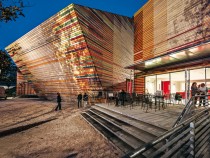
© Marco Caselli Nirmal
In April 2009, L’Aquila, the capital of the Abruzzi region in central Italy, was seriously hit by an earthquake. Residents were moved elsewhere, and since then, permission has been required to enter the heavily damaged city centre. Urban life and cultural activities came to a standstill. The erection of a temporary concert hall last autumn, donated by the Province of Trento, was, therefore, a token of a new beginning. Three colourfully striped wooden cubes catch the eye in the park around the historic Spanish fort on the edge of the old city, with the volume containing the concert hall jutting out at an angle. Tilted and seemingly set on edge, it is flanked by two smaller structures. The northern one is reserved for the musicians, while the western structure houses the foyer, a public cafe and spaces for mechanical services. Glazed corridors lead from these two ancillary volumes into the auditorium, where concertgoers are welcomed by the warm reddish tones of the interior. Built entirely of wood, this concert hall is not unlike a musical instrument in itself. Since the sloping walls reflect sound directly back to its source, however, the internal surfaces had to be treated in order to ensure balanced acoustics. The appropriate sound diffusion was achieved by milling the wall and soffit elements to different widths and depths, and absorbent surfaces were also integrated in the ceiling. In addition, suspended acoustic sails, consisting of curved timber sheeting, serve the needs of sound diffusion.







